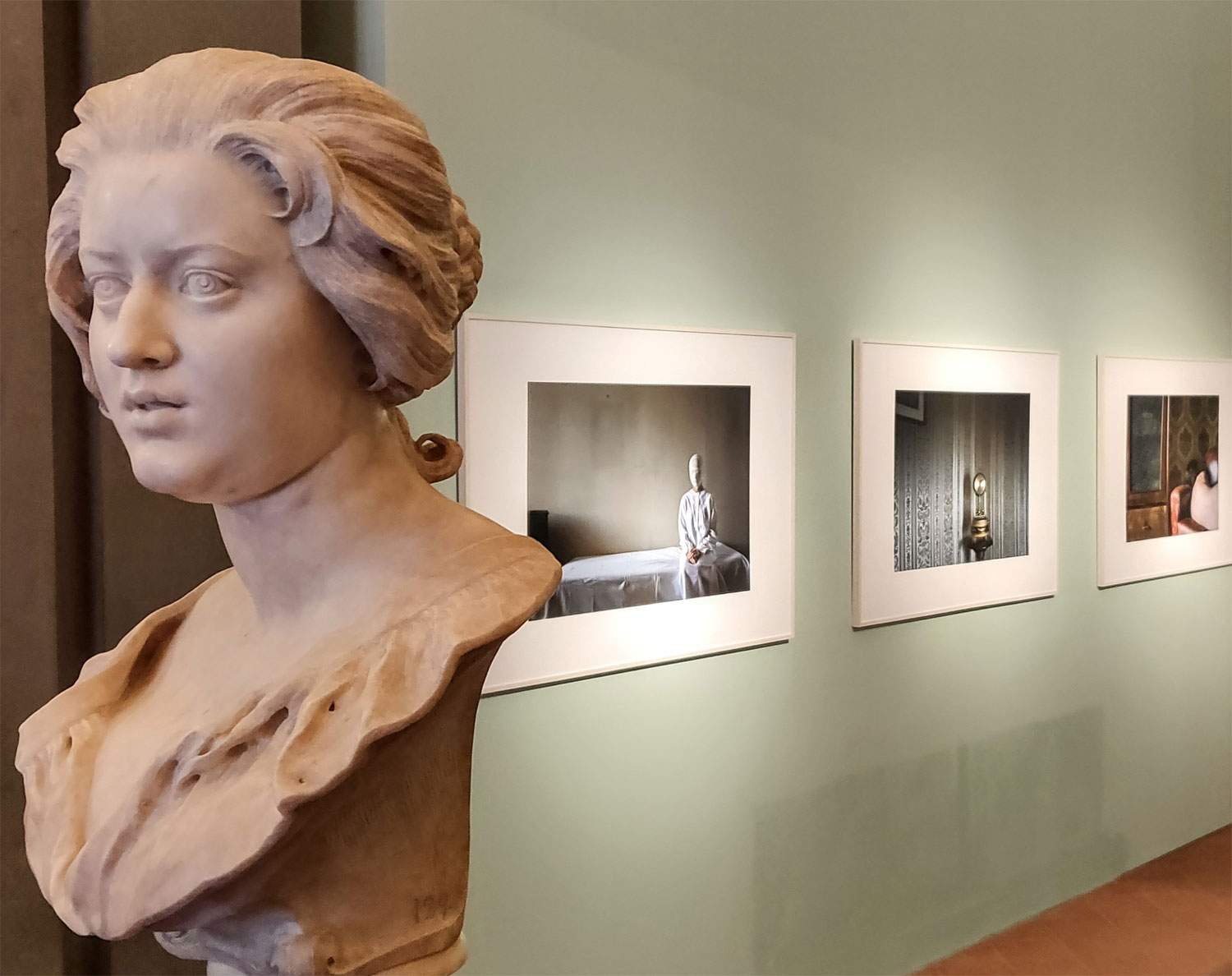The Uffizi Gallery is hosting an exhibition against violence against women from Nov. 2 to Dec. 19. It is Lo Sfregio (The Scarring), an exhibition that puts the works of the young Salerno artist Ilaria Sagaria (Palomonte, 1989) in dialogue with a masterpiece by Gian Lorenzo Bernini (Naples, 1598 - Rome, 1680), the bust of Costanza Piccolomini Bonarelli, restored for the occasion by Maura Masini. Bernini, Costanza Bonarelli’s lover, scarred the woman in an access of jealousy: with the masterpiece, on loan from the Museo Nazionale del Bargello, the Uffizi intends to give voice to a timeless drama by dialoguing with Ilaria Sagaria’s shots that poetically recount the pain and loneliness of the victims of the attacks with corrosive substances.
The extraordinary bust of Costanza Piccolomini Bonarelli, carved in marble by Gian Lorenzo Bernini to pay homage to his beloved, who was later disfigured in the face in an access of jealousy, and the contemporary shots from Ilaria Sagaria’s cycle Pain is not a privilege, dedicated to women disfigured with acid, their faces invisible and bandaged, are the works that intend to initiate a dialogue between ancient and contemporary. The disfigurement, on display on the second floor of the Uffizi Gallery (in the spaces between the Leonardo and Michelangelo rooms), starts with Bernini’s marble bust (datable to 1637-1638), where the sculptor portrays the woman with naturalness and intimacy: the open shirt, the wavy hairstyle, the snap of the neck, the mouth half-open as if to suggest a dialogue. In the late summer of 1638 Bernini, having discovered Costanza’s liaison with his brother Luigi, mad with jealousy, had the woman’s face rubbed off. Bernini was pardoned and continued his brilliant career without consequence, while Costanza was imprisoned in a monastery for four months. She then returned to her husband, Matteo Bonarelli, with whom she started a flourishing sculpture business: in her today is recognized an emblem of the capacity for redemption found in so many victims of violence, to whom Ilaria Sagaria’s photographs, dedicated to women who have suffered acid attacks, lyrically give voice. Indeed, the series of shots The Pain is Not a Privilege recalls how the crime suffered by Costanza is re-actualized today in the even more heinous cases of acid attacks. To be targeted, exactly as then, is the face of the victims, invested by corrosive substances that burn the skin and erode bone and cartilage, condemning them to a physical and psychological ordeal.
Precisely in order to talk about this highly topical issue, Filomena Lamberti, a victim of acid violence and testimonial of the association Spaziodonna of Salerno, Petra Filistrucchi, vice-president of the anti-violence center Artemisia of Florence, Jaf Shah, executive director of Acid Survivors Trust International, brought their testimonies to the presentation of the exhibition. The initiative was also attended by Bargello Museums director Paola d’Agostino, Uffizi board member Valdo Spini, exhibition curator Chiara Toti and photographer Ilaria Sagaria herself.
“Violence through acid,” says Ilaria Sagaria, “is a global phenomenon that is not related to ethnicity, religion, let alone social and geographical position. Although cases of aggression have also been recorded against men, it remains a form of violence with a greater impact on women. In addition to the physical brutality caused by an inhuman act, there is the psychological trauma to deal with: loss of identity, depression, and isolation. After the hospitalization phase, they are forced to spend long periods locked inside the house, and even when they could go outdoors, they refuse to show themselves in public and face the gaze of others. They put away mirrors and their photographs, eliminating anything that might show what they were before and what they became later, thus becoming prisoners of a home deprived of memory and identity. Through their testimonies, I reconstructed a narrative, a photographic mise-en-scène that could restore these moments without spectacularizing their pain, focusing on the psychological aspect and the concept of identity.”
“On the occasion of the exhibition,” stresses Eike Schmidt, director of the Uffizi, “the bust of Costanza Piccolomini Bonarelli has undergone a restoration financed by the Uffizi Galleries: the work can thus be fully appreciated again, thanks to this symbolic act of reparation, however, against the ravages of time. In the exhibition we look at it not only as a masterpiece by one of the greatest Baroque sculptors, but we are invited to reflect on the heinous violence of the strong against the weak. And to meditate on the unspeakable pain of survival.”
 |
| An exhibition against violence against women at the Uffizi. Protagonists Bernini and Ilaria Sagaria |
Warning: the translation into English of the original Italian article was created using automatic tools. We undertake to review all articles, but we do not guarantee the total absence of inaccuracies in the translation due to the program. You can find the original by clicking on the ITA button. If you find any mistake,please contact us.